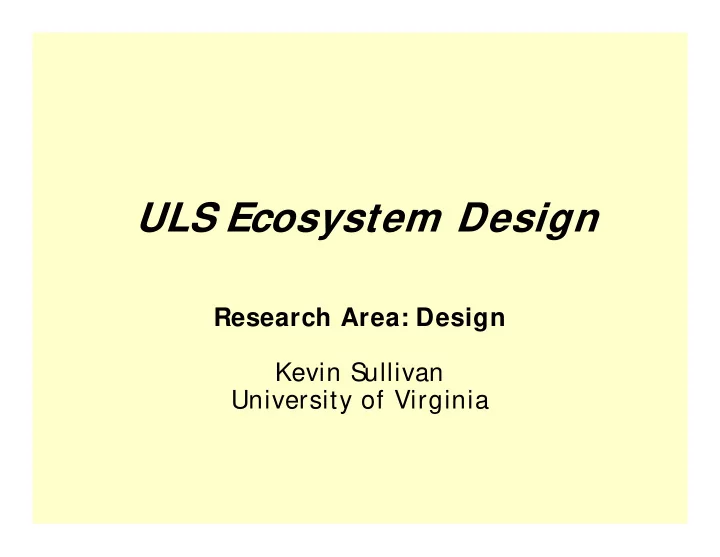

ULS Ecosystem Design Research Area: Design Kevin Sullivan University of Virginia
Today’s Problem • Gap between state of art & practice • Larger than in most other disciplines
Example: Security • State of practice is still terrible overall • Many big problems avoidable in principle
Tomorrow’s Problem State of the art itself deeply inadequate • • “As software’s complexity continues to rise, today’s … problems will become intractable unless fundamental breakthroughs are made in the science and technology of software design and development.” [President’s Council of Advisors on Science and Technology, 07] • Tomorrow’s problem is here today
Today • Define and lock requirements • Contract for development – Partition system & design task: architecture – Subcontract, implement, and integrate: code • Celebrate success
Won’t Work for ULS Systems • No one adequately understands requirements • Conditions change (e.g., security/threat environment) • No one really knows how to build what need to be built • Complexity and uncertainty pose great challenges • Once designed, resistant to change (e.g., IPv4 to IPv6)
Major Mismatches
Key Idea The most critical property of a ULS system is its capacity to adapt to the change dynamics of (including the resolution of risk/uncertainty in) its environment. To be able to assure that given ULS systems have adequate adaptive capacity we need a new discipline of ecosystem architecture. Such a discipline will build on but transcend the discipline of software architecture. Economic considerations will play an important role in such a discipline.
Ecosystem Architecture • Dynamic modeling & monitoring of complex & evolving environments • Move from an emphasis on architecture of software to architecture of socio-technical ecosystems of software/system production, operation, use • Design architecture for high adaptive capacity in the given environments • Coupling of concerns across many levels of socio-technical ecosystem • Example: security – What part(s) of ecosystem will respond to a threat or failure? Autonomic runtime layer? System operators? Software development team? An offensive countermeasures team? Impacts and coordination across multiple levels and administrative domains?
Initial Science Base • Discipline of software design / architecture • Structure and economics of modularity in design • Reactive systems, e.g., for decision support • Complex adaptive systems, biology • Network science …
Today • We’re not even close • Software architecture today – Focus on software artifacts and processes – Notations designed accordingly: e.g., UML – Not socio-technical ecosystem, environment – Box and arrow representations of software and hardware components, interconnections – Need to model/structure/analyze and manage dependences among key parameters across whole ecosystems
Today
Tomorrow • Architecture not about SW and HW components, per se, but about constraints that organize an adaptive optimization process across many levels of a system, including the SW and HW components • Fundamental purpose of architecture is to ensure adaptive capacity commensurate with uncertainty & change dynamics of environment • Adaptation dynamics in many dimensions, at many levels, at many time-scales • Have to design ecosystem, including but not limited to SW/HW, as a key step toward being able to get the SW/HW right • Key issues: decentralization & localization, “hiding” of adaptation needs, mechanisms, and dynamics; economic case for doing this
Structuring Concern Interdependences Across Ecosystem Levels is Critical
Contact • Me: sullivan@virginia.edu • ULSSIS Center: http://ulssis.cs.virginia.edu • ULS2 Workshop: http://ulssis.cs.virginia.edu/uls2, May 10- 11, 2008, ICSE Leipzig, Germany
Recommend
More recommend